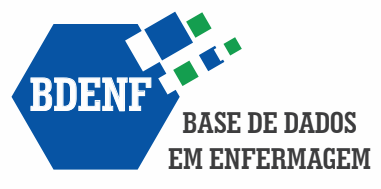CONTRIBUIÇÕES DO ENFERMEIRO NA PESQUISA BÁSICA: MODELO DE FIXAÇÃO DE CURATIVO EM FERIDAS CUTÂNEAS EXCISIONAIS DE CAMUNDONGOS
Resumo
Objetivo: validar método de fixação de curativos em feridas cutâneas excisionais de camundongos. Método: estudo pré-clínico. Amostra composta por animais da linhagem C57BL/6, que tiveram duas feridas excisionais confeccionadas na região dorsal. Foram avaliados diferentes métodos e produtos, amplamente aceitos na prática clínica, para fixação de curativos no modelo animal. Os desfechos avaliados foram tempo de permanência do curativo e ocorrência de eventos adversos. Resultados: atadura de crepom, fita microporosa e bandagem autoaderente apresentaram menor tempo de permanência quando comparadas ao filme de poliuretano. Esse, por sua vez, variou o tempo quando comparadas diferentes marcas (E, F, G e H) e número de voltas ao redor do corpo do animal. Com 1 volta, o tempo variou de < 24 a 36 horas. Com 2 voltas, as marcas E e G permaneceram 48 e 96 horas, respectivamente, e F e H tempo < 24 horas. Filme da marca G, cortado no tamanho 3 cm x 15 cm, dando 2 voltas no corpo do camundongo, manteve o curativo por 96 horas. A pele permaneceu íntegra, sem evento adverso. Conclusão: foi criado modelo de fixação de curativos para feridas em camundongos com produto disponível no Brasil e compatível com a estrutura copórea do animal.
Downloads
Métricas
Referências
Storey S, Wagnes L, LaMothe J, Pittman J, Cohee A, Newhouse R. Building evidence-based nursing practice capacity in a large statewide health system: A Multimodal Approach. J Nurs Adm. 2019;49(4):208-14. https://doi.org/10.1097/NNA.0000000000000739
Perry CJ, Lawrence AJ. Hurdles in basic science translation. Front Pharmacol. 2017;8:478. https://doi.org/10.3389/fphar.2017.00478
Rowsey PJ. Using animals in nursing research: bridging gaps between bench, bedside, and practice. West J Nurs Res. 2015;37(12): 1515-6. https://doi.org/10.1177/0193945915578815
Lodhi S, Vadnere GP. Relevance and perspectives of experimental wound models in wound healing research. Asian J Pharm Clin Res. 2017;10(7):57-62. https://doi.org/10.22159/ajpcr.2017.v10i7.18276
Cai H, Li G. Efficacy of alginate-and chitosan-based scaffolds on the healing of diabetic skin wounds in animal experimental models and cell studies: a systematic review. Wound Rep Reg. 2020; 28(6):751-71. https://doi.org/10.1111/wrr.12857
Parnell LKS, Volk SW. The Evolution of Animal Models in Wound Healing Research: 1993-2017Adv in wound care (New Rochelle). 2019; 8(12):692-702. https://doi.org/10.1089/wound.2019.1098
Hu J, Guo S, Hu H, Sun J. Systematic review of the efficacy of topical haemoglobin therapy for wound healing. Int Wound J. 2020;17:1323-30. https://doi.org/10.1111/iwj.13392
Cashion A, Pickler RH. What Will I Bring: Nurse Scientists’ Contributions to Interdisciplinary Collaboration. Nurs Res. 2018;67(5):347-48. https://doi.org/10.1097/NNR.0000000000000299
Canesso MCC, Vieira AT, Castro TBR, Schirmer BGA, Cisalpino D, Martins FS et al. Skin wound healing is accelerated and scarless in the absence of commensal microbiota. J Immunol. 2014;193(10):5171-80. https://doi.org/10.4049/jimmunol.1400625
Masson-Meyers DS, Andrade TAM, Caetano GF, Guimaraes FR, Leite MN, Leite SN et al. Experimental models and methods for cutaneous wound healing assessment. Int J Exp Pathol. 2020;101(1-2):21-37. https://doi.org/10.1111/iep.12346
Zomer HD, Trentin AG. Skin wound healing in humans and mice: challenges in translational research. J Dermatol Sci. 2018; 90(1):3-12. https://doi.org/10.1016/j.jdermsci.2017.12.009
Cetinkaya RA, Yilmaz S, Ünlü A, Petrone P, Marini C, Karabulut E et al. The efficacy of platelet-rich plasma gel in MRSA-related surgical wound infection treatment: an experimental study in an animal model. Eur J Trauma Emerg Surg. 2018;44(6):859-67.
https://doi.org/10.1007/s00068-017-0852-0
Nikpasand A, Parvizi MR. Evaluation of the effect of titatnium dioxide nanoparticles/gelatin composite on infected skin wound healing; an animal model study. Bull Emerg Trauma. 2019;7(4):366-72. https://doi.org/10.29252/beat-070405
Park SA, Covert J, Teixeira L, Motta MJ, DeRemer SL, Abbott NL et al. Importance of defining experimental conditions in a mouse excisional wound model. Wound Repair Regen. 2015;23(2):251-61. https://doi.org/10.1111/wrr.12272
Stoffel JJ, Riedi PLK, Romdhane BH. A multimodel regime for evaluating effectiveness of antimicrobial wound care products in microbial biofilms. Wound Repair Regen. 2020;28(4):438-47. https://doi.org/10.1111/wrr.12806
Lucena MT, Melo Júnior MR, Lira MMM, Castro CMMB, Cavalcanti LA, Menezes MA et al. Biocompatibility and cutaneous reactivity of cellulosic polysaccharide film in induced skin wounds in rats. J Mater Sci Mater Med. 2015;26(2):82. https://doi.org/10.1007/s10856-015-5410-x
Kaymakcalan OE, Abadeer A, Goldufsky JW, Galili U, Karinja SJ, Dong X. et al. Topical α-Gal nanoparticles accelerate diabetic wound healing. Exp Dermatol. 2020;29(4):404-13. https://doi.org/10.1111/exd.14084
Seth AK, De la Garza M, Fang RC, Hong SJ, Galiano RD. Excisional wound healing is delayed in a murine model of chronic kidney disease. Plos One. 2013;8(3):e59979. https://doi.org/10.1371/journal.pone.0059979
Downloads
Publicado
Como Citar
Edição
Seção
Licença
Copyright (c) 2021 Gilmara Lopes Amorim, Mariana Raquel Soares Guillen, Puebla Cassini Vieira, Eline Lima Borges

Este trabalho está licenciado sob uma licença Creative Commons Attribution 4.0 International License.

























